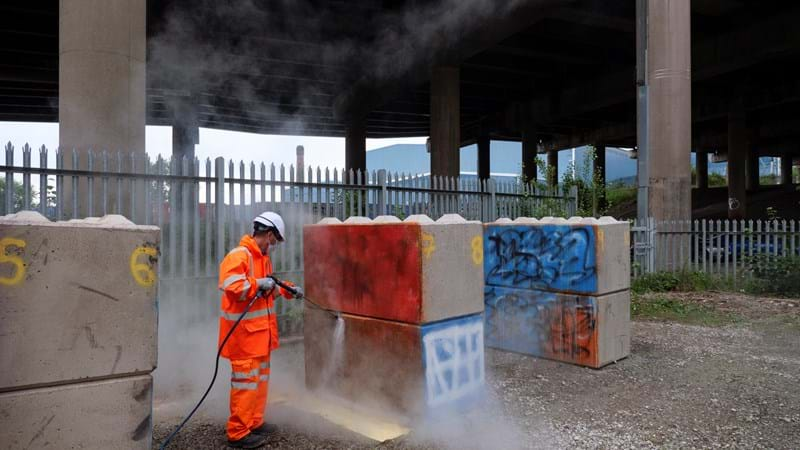Writing on wall for graffiti as Highways England cleans up
Published
07 Jul 2021
Highways England is looking for new products to remove graffiti and prevent vandalism

Share this article
The writing could soon be on the wall for vandals thanks to a new initiative which aims to remove the blight of graffiti from along our road network.
As well as being unsightly, graffiti on bridges and next to roads can be distracting for drivers. Removing graffiti often requires road closures and costs money – up to £10,000 to remove one instance of graffiti.
Offensive graffiti has to be removed within 24 hours which can mean disrupting traffic at short notice.
We're now on a mission to find new products that will remove graffiti and also solutions that will prevent the vandalism appearing.
To tackle the issues, a large testing session took place over two days at an off-road site at Gravelly Hill Interchange – more commonly known as Spaghetti Junction – in Birmingham.
Three products or methods were tested to help identify those that most successfully remove graffiti quickly and safely whilst being eco-friendly. And there were three more that go beyond coatings traditionally used to prevent graffiti appearing.
"We want to identify products that will remove graffiti more effectively than our traditional methods and also those that could prevent it from appearing in the first place"Annette Pass, Head of Innovation, Highways England
Highways England Head of Innovation, Annette Pass, said:
“We know that people don’t want to see roads blighted by vandalism and have been working hard to detect and remove graffiti. But doing so causes disruption to road users and takes away funds that would be better invested in our roads.
“It also means workers having to go out onto the network to clean it off, potentially putting them at risk.
“Through this initiative we want to identify products that will remove graffiti more effectively than our traditional methods and also those that could prevent it from appearing in the first place.”
We have worked with contractor Kier and Connected Places Catapult (CPC) on the initiative.
The techniques tested included ‘super repellent’ anti-graffiti solutions, preventative coatings which saw the paint simply wash off with soapy water or rain water while one firm blasted off the graffiti with recycled glass pellets.
The aim of the trials is to evaluate the performance of newly-identified products and increase the range of solutions available to maintenance contractors such as Kier.
The experience will also give those taking part a valuable insight into what further development would need to be made in order to meet the required standards for approved use by us. We'll be offering participants advice from technical specialists to help with that development.
In addition to the trials, we are also running a competition to identify up to six new and innovative solutions focused on graffiti prevention and deterrence.
More than a dozen companies have submitted their concepts and products which are currently being considered with the most promising entries to be taken forward to the trials stage.
The cost of the initiatives has been met through our Innovation and Modernisation Designated Fund. This is a ring-fenced fund dedicated to the exploration and adoption of modern and innovative working practices.
The companies taking part in the trials were:
- Blocksil (Removal)
- Dacrylate (Prevention)
- Pristine (Prevention)
- CC Infrastructure Services (Removal)
- Ecoblast Supplies Ltd (Removal)
- AGS One Ltd (Prevention)
